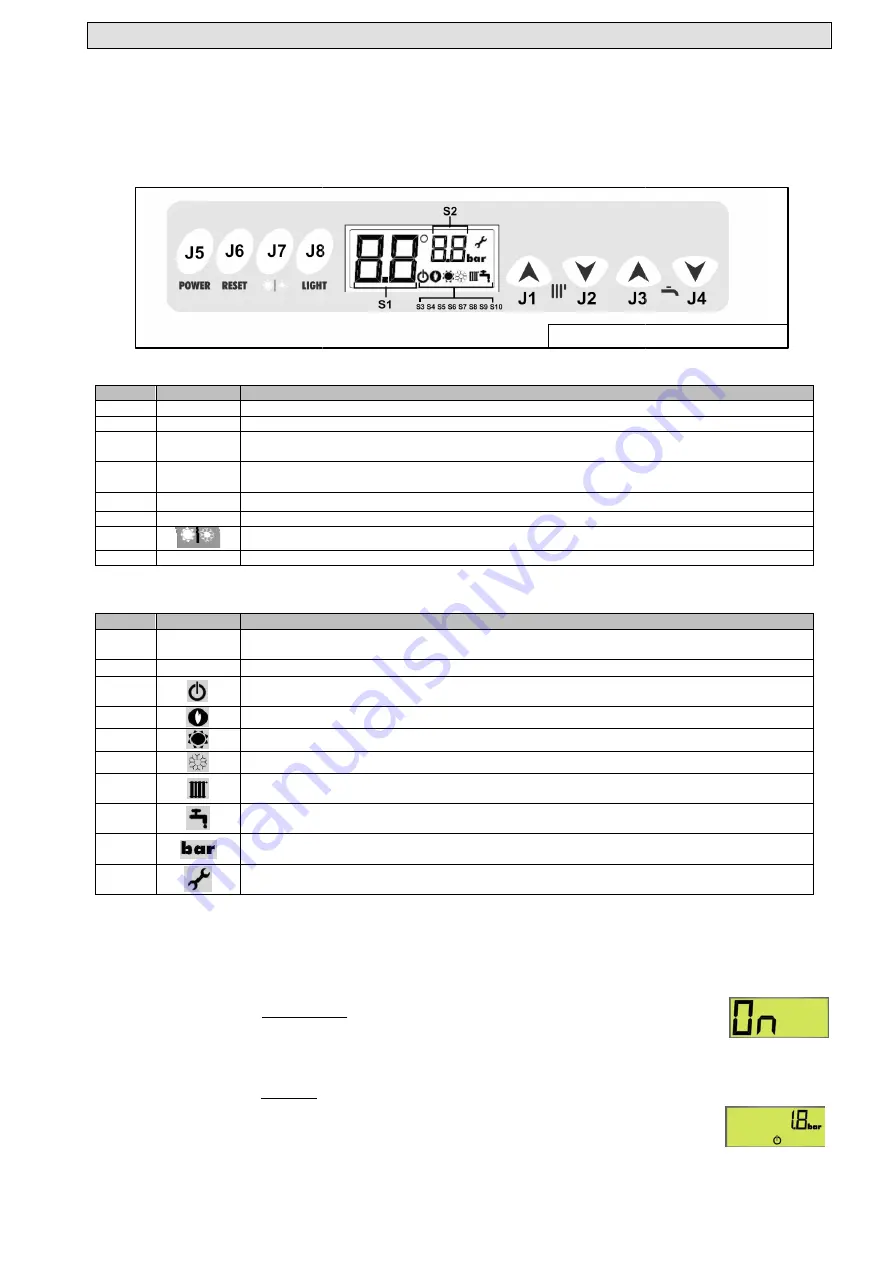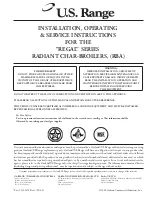
USER MANUAL CENTRAL HEATING STATION TYPE
REV.12.06.2017
9
Operation instructions
9.1
Control Panel
The LMC1112 control panel (fig.1.5) allows the visualization and change of parameters
central heating station. It consists of:
-
8 keys (J1÷J8) - tab.3
-
LCD display, where communication messages (graphic symbols)
(S1÷S10) is presented in table 4.
Table 3: Control panel keys
Key
Symbol
J1
CH +
Used to increase the set thermal temperature or to navigate the installation submenu
J2
CH -
Used to decrease
J3
DHW +
Used to increase the set temperature on hot water circuit or the value of the current parameter
in the installation submenu
J4
DHW -
Used to decrease the set temperature on hot water circuit or the value
parameter in the installation submenu
J5
POWER
Used to switch
J6
RESET
Used to reset the electronic control board from an error state
J7
Used to change the functioning mode winter/ summer
J8
LIGHT
Used to activate/ deactivate the light on the display
Table 4: Description of graphic symbols in the LCD display
Key
Symbol
S1
It diplays the temperature (°C), set value, parameter values, informative values, various
messages („On”, “SP”,
S2
It displays informative
S3
It shows the state of the central heating station (Closed
inactive symbol
S4
It shows the presence of flame
S5
It shows whether the
S6
It shows whether the set functioning mode is WINTER
S7
The symbol is displayed continuously, which means that the station functions as thermal station.
The symbol is displayed interrupted whenthe thermal temperature is set.
S8
If this symbol is displayed continuously it means that the station functions as hot water station.
The symbol is displayed interrupted whenthe hot water temperature is set.
S9
It shows the fact that the S2 symbol displays the value of the pressure inside the installation
(active symbol
S10
It shows the fact that there was an unsaved change of parameters in the EEPROM
memory (it flashes
9.2
Description of functions and of graphic contexts diplayed on the control panel LMC1112
9.2.1
LIGHT function
LIGHT
k e y ( J8 fig.1.5) is used to activate/ deactivate the light on display function.
9.2.2
Graphic context – station startup
When started, the station is in an intermediary
During this interval the diplay shows only the message
figure 1.6).
9.2.3
Graphic context - Stand-by
This context is associated with an inactive/
state all the activation elements are inactive and every burning demand is ignored.
USER MANUAL CENTRAL HEATING STATION TYPE C32SPV24MEC; C32SPV31MEC
allows the visualization and change of parameters defining the functioning of the
LCD display, where communication messages (graphic symbols) are displayed. The meaning of the 10 types of symbols
Description:
Used to increase the set thermal temperature or to navigate the installation submenu
Used to decrease the set thermal temperature or to navigate the installation submenu
Used to increase the set temperature on hot water circuit or the value of the current parameter
in the installation submenu
Used to decrease the set temperature on hot water circuit or the value
parameter in the installation submenu
Used to switch the station on/ off
Used to reset the electronic control board from an error state
Used to change the functioning mode winter/ summer
Used to activate/ deactivate the light on the display
: Description of graphic symbols in the LCD display
Description:
It diplays the temperature (°C), set value, parameter values, informative values, various
messages („On”, “SP”, “Co”, “EI”, “SI”, etc.)
informative values, parameter values, pressure
It shows the state of the central heating station (Closed (OFF) = active symbol, Open (ON) =
e symbol)
It shows the presence of flame
It shows whether the set functioning mode is SUMMER (active symbol
It shows whether the set functioning mode is WINTER (active symbol)
The symbol is displayed continuously, which means that the station functions as thermal station.
The symbol is displayed interrupted whenthe thermal temperature is set.
If this symbol is displayed continuously it means that the station functions as hot water station.
The symbol is displayed interrupted whenthe hot water temperature is set.
It shows the fact that the S2 symbol displays the value of the pressure inside the installation
e symbol)
It shows the fact that there was an unsaved change of parameters in the EEPROM
memory (it flashes)
graphic contexts diplayed on the control panel LMC1112
is used to activate/ deactivate the light on display function.
station startup
When started, the station is in an intermediary state for 5 seconds, necessary to initialise the system.
During this interval the diplay shows only the message “
On
” on the S1 symbol on the interface
associated with an inactive/ waiting state of the central heating station. In the stand
state all the activation elements are inactive and every burning demand is ignored.
Fig. 1.5 LMC1112
10 of 18
defining the functioning of the
are displayed. The meaning of the 10 types of symbols
Used to increase the set thermal temperature or to navigate the installation submenu
or to navigate the installation submenu
Used to increase the set temperature on hot water circuit or the value of the current parameter
Used to decrease the set temperature on hot water circuit or the value of the current
It diplays the temperature (°C), set value, parameter values, informative values, various
e symbol, Open (ON) =
e symbol)
)
The symbol is displayed continuously, which means that the station functions as thermal station.
The symbol is displayed interrupted whenthe thermal temperature is set.
If this symbol is displayed continuously it means that the station functions as hot water station.
The symbol is displayed interrupted whenthe hot water temperature is set.
It shows the fact that the S2 symbol displays the value of the pressure inside the installation
It shows the fact that there was an unsaved change of parameters in the EEPROM
graphic contexts diplayed on the control panel LMC1112
state for 5 seconds, necessary to initialise the system.
symbol on the interface (see
waiting state of the central heating station. In the stand-by
LMC1112 control panel
Fig.1.6
Fig.1.7




































